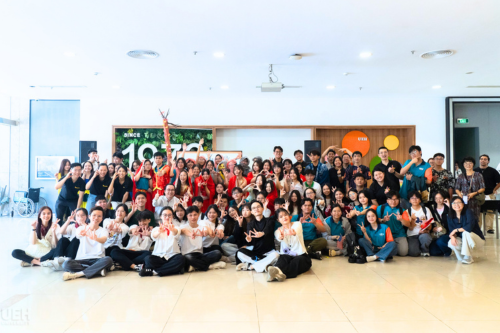![[Podcast] Artificial Intelligence Technology Application in Vietnamese Financial Services – Part 2: Policy Recommendations](/images/upload/img_background/ueh-bg-020732-090922.png)
[Podcast] Artificial Intelligence Technology Application in Vietnamese Financial Services – Part 2: Policy Recommendations
07 Sep, 2022
Artificial intelligence (AI) technology is increasingly being adopted globally and is definitely bringing about core changes in a number of industries, including financial services. In this development trend, in Vietnam, the application of AI technology in the fields of asset management, risk management and financial consulting services is being rather limited. Through the AI technology application trend in the Finance - Banking industry in Vietnam that was analyzed in part 1, part 2 of this article will present policy recommendations to develop AI technology in the current Vietnamese financial situation.

Risks and challenges of Artificial Intelligence in Finance
While a number of studies on AI in governance and finance highlight the advantages and the benefits of this technology in various applications, AI users should also be aware of some of its risks and disadvantages for financial asset management. These potential negative problems are often related to complexity, opacity, and dependence on data integrity (Figure 3).
Understanding and interpreting the inferences made by most AI models is difficult, even, impossible. As the complexity of the task or algorithm increases, this opacity can make human supervision less effective, leading to a significant problem which can have consequences for the property manager in 3 ways as follows.
Firstly, the difficulty in predicting how AI models will respond to big surprises or ‘black swan’ events like the Covid-19 epidemic can lead to systematic breakdown. Even AI algorithms, in the absence of unusually large events, can make the same mistakes at the same time, leading to the risk of a market crash. Because of the significant cost of producing AI algorithms, most asset management companies use the same tools and algorithms. As a result, systemic risks posed by AI are likely to occur more frequently and with greater severity than those in the past using traditional algorithms. What makes AI risky is its complexity and the ambiguity that make it very difficult for users to prevent such risks.
Secondly, AI can make erroneous decisions based on incorrect estimates when data appears interfered or unrelated patterns occur in the data. Therefore, in cases where an investment fund is underperforming, it can be difficult to explain to investors how and why an investment strategy has failed, which can undermine the investors’ confidence towards the fund or even the industry. Furthermore, the “black box” characteristic of many AI systems raises the accountability issue and causes legal and compliance issues to become more difficult.
Thirdly, data quality is also a significant risk upon using AI in the financial sector. Like other empirical models, AI models are based on data accuracy and completeness. Poor data quality can easily produce false signals as a very commonly used term to describe this phenomenon “garbage in, garbage out”.
In addition, some researchers argue that the past data may generally not be fully representative of what may happen in the future. This shortcoming can be exacerbated when financial data series miss some key extreme events in the past, increasing the likelihood that AI models will fail to forecast when extreme events occur, for example, a financial crisis or an epidemic. On the other hand, the growing presence of AI in the financial investment industry and the reliance of asset managers on AI for day-to-day tasks can further increase the property managers’ security risks.
Some recommendations for AI usage improvement in the financial sector
Based on the analysis above, the authors propose some recommendations to improve the use of AI in the financial sector as follows.
Firstly, the Vietnamese government has been very timely when it comes to policies that pave the way to explore and to facilitate the AI technology development in the present and in the future. However, the legal framework for implementing a regulatory sandbox for banking and financial services should be implemented as fast as possible in order to meet the needs of creativity and innovation using AI technologies in the financial service sector.
Secondly, the biggest reason for this limitation to be mentioned is the quality of data in both quality and quantity in Vietnam on the financial sector has not been guaranteed. To be able to promote the wider application of AI in the financial sector, it is necessary to standardize financial statements and to promote the disclosure of financial information and business activities of enterprises that must be implemented before AI technology application can be thought of.
Thirdly, with their data advantages, state agencies in charge of policy making can gradually deploy AI application in forecasting and analyzing data on the relevant macro-economy and financial industry. In particular, AI can be used as a warning tool for strong fluctuations in the macro-economy so that the appropriate response policies can be issued in a timely manner.
Fourthly, using AI technology to ensure compliance with industry regulations and legal regulations, also known as Regulatory Technology (RegTech), should also be of interest and widespread in the financial industry and other related industries.
Fifthly, as being used in an emerging economy, the use of AI technology will face a big psychological barrier from the users. Therefore, the leading role of large enterprises in the financial industry, especially large financial institutions in Vietnam, must be the pioneer in technological innovation and AI application more in these products/services.
Policies regarding human resources and technical infrastructure development
In addition, the policies to develop human resources and technical infrastructure are proposed as follows:
Firstly, changing the training mindset at undergraduate and graduate institutions/universities is very important. Not only being in cooperation with economic organizations and financial institutions to create immediate human resources to meet temporary scarcity needs, universities in diverse fields (natural sciences, social sciences) need to work together to create training programs that combine the necessary knowledge and skills for specialized human resources for the Vietnamese digital economy. In order to cause this policy to become feasible, the leadership role of the Ministry of Education and Training, which is the main body that guides training policy on a macro scale, needs to be demonstrated.
Secondly, promoting cooperation between financial institutions - banks as end users and specialized enterprises providing technical infrastructure and high-tech services. Beyond performing cooperation, creating an ecosystem of businesses specializing in providing services and technologies in the field of AI is essential. The success in applying technology to the payment field through the cooperation among payment technology enterprises and financial institutions listed as banks is a typical example and should be exploited to learn for success and failure lessons.
Thirdly, the role of state management agencies in the banking and finance sector in creating a supportive environment for the development of AI technologies in the investment sector. Currently, there has been no government agency in the financial sector that has taken the lead in applying AI technology to policy management and macroeconomic management while state agencies are the most fully-resourced places in the development of infrastructure and AI technology. This creates a huge gap in dissemination and sets a good precedent for private sector adoption and AI technology use as well as consumer confidence. For the current trend, state agencies in the developed countries have also been considering the AI technology application more deeply in their state management fields. State management agencies in Vietnam should consider investing this as soon as possible. A methodical investment strategy with abundant resources from state agencies will create a ‘push’ in the development of technical infrastructure and the popularity of the AI field in general and in the finance investment field in particular.
To develop a useful AI application does not necessarily require too many financial resources and technical systems. A technology system at the current level of popularity along with current programming languages that open-source codes for machine learning applications and the community of programmers can help develop AI applications. Currently, the access to machine learning techniques is no longer beyond the reach of businesses and individuals in Vietnam. The biggest difficulty lies in the collection and the processing of financial data in Vietnam because the data being stored is not synchronized and the data quality (completeness) has not been optimally guaranteed. On the other hand, the above-average performance of these simple machine learning techniques speaks to the huge potential of AI application in financial investment now and in the near future.
Please refer to the full research Artificial Intelligence Technology Application in Vietnamese Financial Services here. Author group: Dr. Ngô Minh Vũ, Dr. Nguyễn Hữu Huân – Faculty of Banking, UEH College of Business.
This is in series of Spreading researches and applied knowledge from UEH with “Research Contribution For All” message, UEH would like to invite valued readers to follow Newsletter ECONOMY NO. #57.
News, photos: Author group, UEH Department of Marketing – Communication
Voice of: Ngọc Quí


![[Contribution Research] How Ho Chi Minh City students’ green product consumption is affected by application iCTs innovation nowadays: A case for business to enhance green product consumption by understanding the role of environmental concerns, green consumption value and perceived effectiveness](/images/upload/thumbnail/ueh-thumbnail-639044087939815424.png)



![[Research Contribution] Determinants impacting young consumers purchasing behavioral intention on sustainable fashion: exploration in Ho Chi Minh City](/images/upload/thumbnail/ueh-thumbnail-639035712273480983.png)






![[Research Contribution] What influences UEH students’ attitudes toward the “UEH Zero Waste Campus” project](/images/upload/thumbnail/ueh-thumbnail-639033816949877456.png)